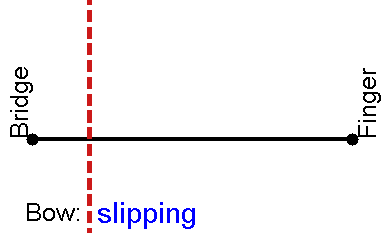How to observe Helmholtz motion for yourself
The experiment being carried out
Armed with a violin and bow, an oscilloscope, and a small bar magnet, it is easy to observe Helmholtz motion and other bowed-string effects. Choose a string with a metal core or covering, so that it conducts electricity. Attach wires to the ends of the string away from the active vibrating portion: that is, in the peg-box or behind the violin bridge. Connect the wires across one input channel of the oscilloscope. Bow the string, and hold one end of the magnet close to the vibrating string without touching it. As the string moves through the magnetic field near the end of the magnet, a voltage will be generated by Faraday induction. This voltage is proportional to the velocity of the string near the magnet. The voltage will produce a waveform on the oscilloscope. The experiment works best if you use the strongest magnet you can find, and turn up the gain on the oscilloscope to its maximum, because the voltage from the string is not very large.

Helmholtz motion
Now recall what the string is doing during Helmholtz motion. All the time the moving corner is to the left of the point on the string where the magnet is placed, the string near the magnet will have a constant velocity. When the corner is on the right-hand side of the magnet, the string will have a different constant velocity (with the opposite sign). It follows that the waveform you expect to see will be a pulse wave, alternating between the two (approximately) constant levels. If the magnet is in the middle of the vibrating string, the waveform should be a symmetrical square wave. As the magnet is moved away from the middle of the string the symmetry is lost and pulses should be seen which get narrower as the magnet approaches the end of the string.
Typical image from the oscilloscope when the magnet is held near the centre of the string. The small ripples which can be seen superimposed on the square wave are caused by waves on the string reflecting from the bow. Move the bowing position along the string and you should see the ripple period change.
How did Helmholtz observe the motion?
In the nineteenth century, Helmholtz did not have the possibility of using an oscilloscope to observe string vibration. Instead, he made a kind of mechanical stroboscope. He used a string which was blackened except for a white dot, and he observed it in a dark room through a microscope attached to a vibrating tuning fork.
Modern technology offers an easier to way to do a similar direct observation: if you have access to a strobe light with a flashing frequency which can be varied, you can use it to illuminate a bowed string. By choosing a flashing frequency close to the string frequency but not quite the same, you can show the string vibration in slow motion. The travelling Helmholtz corner is most easily seen if you look along the length of the string, rather than looking at it from the side.